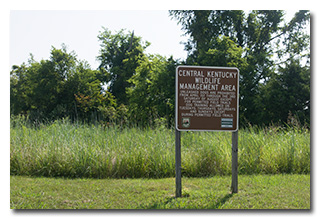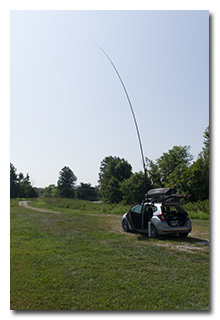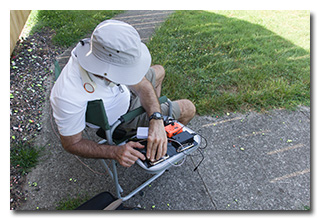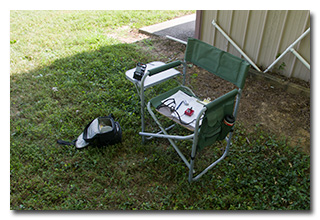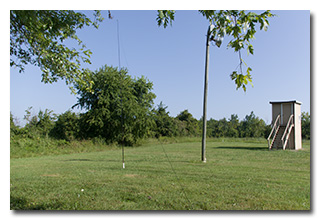Description
On Sunday, August 10, 2025, one member of the Southeast Ohio Radio Adventure Team performed a successful activation of Miller Welch Wildlife Management Area (US-3825) in Kentucky as part of the Parks on the Air (POTA; link) program.
On the way back to Ohio following participation as a radio operator in Boone Forest Rally, Eric McFadden, WD8RIF, stopped at Miller Welch Wildlife Management Area for the activation. Eric was accompanied by his friend Len Touth, W8VQ, who performed his own POTA activation.
Eric and Len arrived at the wildlife management area's Parrish Tract Lake access point at about 1330 UTC to find the cul-de-sac to be overgrown, with no clear area or shade in which to set up stations and operate. The pair investigated the adjacent skeet hunting facility, which is was unoccupied, and decided that the place would work well for portable HF radio.
Eric and Len both had cell-signal, and they would be able to access POTA Spots to spot themselves and to identify Park-to-Park (P2P) QSO opportunities.
For his activation, Len decided to operate his own station, a (tr)uSDX transceiver and a 40m EFHW antenna, instead of trying Eric's KX2. To support Len's antenna, Eric deployed his Jackite 31' telescoping fiberglass mast in a drive-on base, and Len sloped his 40m EFHW up to the top of this mast. Len placed one of Eric's folding campchairs in shade provided by a skeet shooting observation tower, and placed his (tr)uSDX on the campchair's flip-up table. By this time, Eric was already operating on 20m, so Len began his operation on 40m.
For his part, Eric found a shady spot next to the building, and deployed his Tufteln (link) 35' EFRW as a sloper to the top of his Goture Red Fox Super Hard 720 carbon-fiber mast held upright on a spike, laying three 17' counterpoise wires directly on the ground. Placing his KX2 on his campchair's flip-up table, Eric was on the air at 1402 UTC.
Eric began his operation on 20m. Finding himself a clear frequency to run, he began calling "CQ POTA" and his first QSO came at 1402 UTC, before Eric had even been spotted to POTA Spots, with W1PID in New Hampshire. After this QSO, Eric continued calling "CQ POTA" and was pretty quickly autospotted on POTA Spots. His second QSO came at 1404 UTC with AB1CW in Massachusetts. QSOs came steadily, with Eric's eleventh QSO coming at 1421 UTC with K3KWB in Maryland. This run included a P2P QSO with N1BS at Hillsdale Preserve Management Area (US-10545) in Rhode Island, a P2P QSO with KB3CMT at Shawnee State Park (US-1420) in Pennsylvania, and QSOs with operators located in Connecticut, Florida (2), Maryland, Massachusetts, New Hampshire, New Jersey, Pennsylvania (2), Rhode Island, and Texas.
Pausing to hunt for P2P QSOs, at 1423 UTC Eric turned his KX2 output down to 100mW and made an easy P2P QSO on 40m with Len.
After verifying that Len was happy to stay on 40m, Eric started a second run on 20m. His first QSO in this run came at 1427 UTC with NN2X in Texas. As before, QSOs came steadily, with Eric's eighth QSO in this run coming at 1440 UTC with K1NF in Maine. This run included a P2P QSO with KE2EKI at Ramapo Mountain State Forest (US-4998) in New Jersey and QSOs with operators located in Florida, Kentucky, Maine (2), New Jersey, New York, South Dakota, and Texas.
In all, Eric made twenty QSOs, with four P2P QSOs, in thirty-nine minutes of on-air time. All of Eric's QSOs were CW and were made at five watts output.
Len validated his activation with ten QSOs. All of Len's QSOs were CW at about 2 watts output.
(return)

